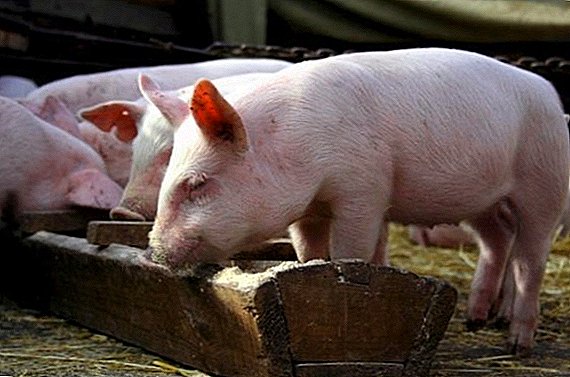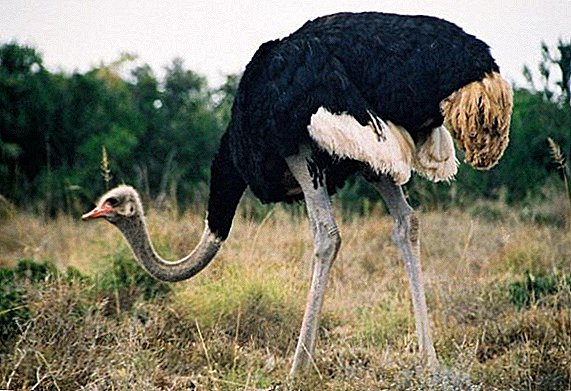 Domestic ostriches are subject to various ailments. An ostrich farmer should know what diseases an exotic bird is prone to in order to prevent the development of the disease. This article focuses on the most common diseases of ostriches, their symptoms, methods of treatment and prevention.
Domestic ostriches are subject to various ailments. An ostrich farmer should know what diseases an exotic bird is prone to in order to prevent the development of the disease. This article focuses on the most common diseases of ostriches, their symptoms, methods of treatment and prevention.
Respiratory diseases
Due to poor immunity and because of adverse conditions in the ostriches respiratory diseases caused by pathogens occur.
Bird flu
This disease is caused by a group A virus and is characterized by lesions of the respiratory system, digestive tract, edema and depression. The disease is transmitted by airborne droplets, as well as through food and contaminated equipment.
Symptoms:
- refusal to eat;
- greenish urine;
- discharge from the eyes;
- inflammation of the chest air sacs.
Important! Confirm the disease can only laboratory tests, because the symptoms of avian flu is similar to signs of other infections.Treatment Ostriches are carried out with the help of special expensive antibiotics that can be purchased at the sanitary and epidemiological surveillance services. Birds with an acute course of the disease are destroyed to prevent the spread of infection.
 Prevention:
Prevention: - avian influenza vaccination;
- avoiding contact with sick birds;
- daily cleaning;
- good air circulation;
- favorable temperature;
- lack of drafts.
Mycoplasma
An infectious disease is characterized by lesions in the air sacs, nasal mucosa and lungs. The source of the pathogen are sick and ill birds, carriers of mycoplasmosis. Infection occurs through the respiratory system. The disease is often prone to strausita at the age of one year. Mortality of young stock - 20-30%.
The spread of mycoplasmosis contributes to the absence of normal conditions:
- undernourishment;
- lack of vitamins;
- poor ventilation;
- high humidity.
 Symptoms:
Symptoms:- serous nasal discharge;
- swelling of the sinuses;
- general weakness;
- hard breath;
- wheezing;
- cough;
- increase in body temperature by 1 ° C;
- lack of appetite;
- reduced egg production.
Read more about breeding ostriches at home.
Prevention.
A live vaccine Nobilis Mg 6/85 has been developed against the respiratory mycoplasmosis of birds, which protects against the onset of symptoms, increases egg production and reduces the risk of transmission of the pathogen. 
Bacterial Respiratory Diseases
Respiratory diseases are caused by different pathogens. The most common causes of an outbreak are unsatisfactory conditions of detention, weak immunity.
Treatment Bacterial diseases are performed with a properly selected antibiotic.
Did you know? The scientific name of ostriches in Greek means "sparrow-camel."
Prevention:
- prevent overcooling and wetting of birds;
- provide complete feeding with added vitamins.
Respiratory diseases caused by poor air composition
In the dwelling for ostriches, the rate of ammonia content in the air, which is released from bird faeces, increases. Ammonia is a poisonous gas. Since the ostrichs sleep with their heads down, the toxic and irritating smell of gas can cause respiratory diseases in the herd.  In addition, to provoke the development of the disease can:
In addition, to provoke the development of the disease can:
- dust;
- inappropriate ambient temperature;
- lack of shelter;
- the presence of drafts.
Prevention:
- well ventilated room, lack of drafts;
- keeping poultry on pallets;
- everyday cleaning of the pen;
- the use of drugs to reduce ammonia excretion.
Foreign body in the airways
During the meal, crushed feed from the feeders can be sprayed and deposited in the respiratory organs of birds. Contact with respiratory organs of foreign bodies is a common cause of asphyxiation or death. But large pieces of food, such as coarsely chopped carrots, can get stuck in the esophagus and lead to death.
Prevention:
- food should be served only in medium and small sizes;
- every day to observe the absence of third-party items in the pen.

Stasis (immobility)
Stasis is a disease in which the ostrich has no appetite and stops moving. To cure the disease, you need to establish the cause of the deterioration of appetite and eliminate it.
Gastrointestinal diseases
Diseases of the gastrointestinal tract are the most common among ostriches. Farmers often experience poultry fungal infections of the stomach, worms and digestive disorders.
Fungal gastritis
This common infectious disease among ostriches results from the defeat of the stomach wall with a fungus, injured by foreign objects, or the use of poor-quality food that is infected with fungus.
Treatment: It is almost impossible to self-cure the bird, it is recommended to call the vet.
Worms
Flatworms are quite common. To detect the presence of worms in the livestock is possible only by conducting regular laboratory studies of ostrich feces.
Learn how to get worms from chickens.
Symptoms:
- poor appetite;
- slow weight gain or reduction.
 Treatment: deworming carried out as needed. This is due to the high cost of special drugs, and their incorrect use leads to the development of resistance to parasites.
Treatment: deworming carried out as needed. This is due to the high cost of special drugs, and their incorrect use leads to the development of resistance to parasites.Did you know? Ostrich eggs - the largest of all birds. One ostrich egg replaces 30 chicken eggs and weighs about 1.8 kg. It can take more than an hour to cook such a hard-boiled egg.
Enteritis
Together with food, ostriches can catch various infections that lead to gastrointestinal disorders.
Viral enteritis
This viral disease is not often diagnosed in ostriches. Their intestines are able to quickly absorb water, so diarrhea can occur only when the intestine is infected with a virus. Typically, this type of disease may be accompanied by another type of enteritis - bacterial.
Treatment It is carried out only after consulting a veterinarian, who will establish the cause of diarrhea and prescribe the correct treatment.  Prevention.
Prevention.
Viruses that cause intestinal disorders in ostriches have not been fully studied, but experimental vaccines have been developed to combat them, information about which can be obtained from sanitary-epidemiological stations and zoo veterinary services.
Bacterial enteritis
This disease is caused by all sorts of disease-causing organisms, including Salmonella. Anthelmintic drugs, overdosing of crude alfalfa, various parasites and viral infections can provoke bacterial enteritis.
Important! Before you give the ostriches alfalfa, you need to feed them granulated food.Symptoms:
- general malaise;
- lethargy;
- imbalance;
- liquid feces.
- prevent overpopulation;
- maintain a high level of hygiene;
- to treat and prevent infectious diseases.

Parasitic enteritis
In the colon and appendix of ostriches parasitizing bacterium Balantidium Coli settles. It is she who creates problems for the bird. In the cloaca and small intestines, one can find the cryptosporidium parasite, which affects the pancreas and its ducts, as well as the liver and kidneys.
Treatment: there is no effective treatment for this disease.
Nervous (musculoskeletal) diseases
The most common in ostriches are musculoskeletal diseases.
Newcastle disease
This disease is especially dangerous and is manifested by damage to the respiratory organs, the gastrointestinal tract, and the central nervous system. Ostriches often become infected with chickens. The disease is particularly susceptible to ostrichs aged up to nine months. The most accurate diagnosis can be obtained using laboratory tests.
We recommend reading about how to treat Newcastle disease in chickens and pigeons.
Symptoms:
- weakness;
- drooping nape;
- movement disorder.
 Treatment: drugs for the treatment of ostriches from this disease is not yet, therefore, often the death of birds.
Treatment: drugs for the treatment of ostriches from this disease is not yet, therefore, often the death of birds.Botulism
Botulism refers to foodborne toxicoinfections and is an acute infectious disease. The pathogen affects the nervous system. The source is an anaerobic sporiferous bacterium that releases a strong poison - exotoxin. Diagnosis can be made by laboratory tests.
Symptoms:
- mild paralysis;
- vision problems;
- diarrhea;
- loss of plumage.
You will probably be interested in reading about how to collect and store ostrich eggs before incubation, how to incubate ostrich eggs at home, as well as how to make an incubator for ostrich eggs with your own hands.
Treatment even with complete paralysis is successful. A therapeutic serum is administered to the ostrich, and after a few days it completely recovers. It is important to identify and exclude the source of infection, otherwise the disease may flare up again.
Prevention:
- vaccination of all ostriches on farms with particular cases of botulism;
- sanitary prevention of drinking water;
- feeding hygienically benign fresh feed.

Encephalopathy
This acute disease affecting the brain resembles Newcastle disease. The causative agent of encephalopathy is a virus, the origin of which is still not known.
Did you know? One blow with a strong ostrich leg can severely injure or kill a lion, break a thick tree trunk.Symptoms:
- change in respiratory rhythm;
- unsteady gait;
- impaired coordination of movements;
- temperature increase;
- malaise;
- drowsiness;
- trembling limbs.

Poisoning
Poisoning of ostriches occurs as a result of overdose and improper use of medicines. Birds are often poisoned by herbs.
Sources of poisoning are plants such as the autumn crocus, the wolfpicker, different types of parsley, parsnip, parsley in large quantities, as well as the St. John's wort, which causes increased phytosensitivity when eaten.
Important! The diet of ostriches should meet their needs. Food should be rich in protein, calcium and phosphorus.
Leg deformities
Osteoporosis, soft bones, is found in the majority of hatched Strausits. In day-old chicks, with increased humidity, an increase in legs develops in the incubator, and during the next two days their legs are seen leaving. But one of the most frequent deformities in ostrichs is the curvature of the toes.
Causes of limb deformation during growth can be:
- lack of essential minerals in the diet, as well as B-complex vitamins and vitamin D (rickets);
- small pen size and tight fit.
 In older ostriches, deformations occur as a result of dislocation of the legs, swelling of the ankle joint.
In older ostriches, deformations occur as a result of dislocation of the legs, swelling of the ankle joint.Treatment: in the early stage of the disease, a tourniquet with a board or stick for a period of 7 days is applied to the affected leg. Driving legs can be locked in position by applying a tire.
Prevention. To prevent limb deformation, you need to enter into the diet of food rich in vitamins, amino acids, macro-and micronutrients.
Fractures
Unfavorable conditions and poor nutrition can cause brittleness and fragility of the bones. An ostrich can break a bone when it strikes a fence or fence while walking on icy surfaces in the winter season. Often, there is muscle damage.
Treatment: broken or damaged bones and wings are processed and fixed in a normal position until complete healing (about 3-4 weeks).
Myopathy
This disease is the result of an excess or lack of nutrition of vitamin E and trace element selenium.
Treatment: if it is reliably known that there is not enough selenium in the body of the bird, selenium supplements are added to the diet. Otherwise, it is not used - selenium is very poisonous. 
Hypoglycemia
The disease occurs after a long fasting of the bird, as the amount of sugar in the blood decreases.
Symptoms this disease is very similar to Newcastle disease.
Treatment: rapid recovery occurs after glucose is introduced into the body.
Did you know? An ostrich cannot fly, but runs faster than a horse! The speed of a monthly ostrich bird can reach 50 km / h. A running ostrich makes steps up to 4 m long.
Dermatological diseases
Since the skin and feathers of ostriches are highly valued in the markets, it is important to know about the most dangerous skin diseases in order to prevent their development in time.
Bird pox
Outbreaks of bird pox in ostriches occur in late summer. During this period, there is the largest number of insects that carry the virus. Chicks aged 1 to 4 months are subject to the disease. Mortality reaches 15%.  Symptoms:
Symptoms:
- pathological formations in the form of warts in the eye area;
- in bird disease of the dipteroid type - nodules on the mucous membranes of the oral and nasal cavities, as well as in the larynx.
Prevention:
- timely vaccination;
- strict compliance with the quarantine regime for new birds.
Infectious dermathopathy
Infectious dermatopathies often occur in overfed ostriches. Rash on the skin near the eyes, on the legs and toes, thicken and cover with crusts. The cause of such rashes is unbalanced nutrition. Only a veterinarian can determine this disease.
Did you know? Excellent vision and high growth help the ostrich to see the approaching predator at a distance of up to 5 km.Treatment carry out local antifungal drugs.

Skin parasites
On farms there are ectoparasites that feed on bird feathers, skin flakes, blood protruding from wounds. These include feather mites. They markedly worsen the valuable bird feathers. Find lice in ostriches can be very rare.
Treatment: an effective remedy for parasites is considered “purified sulfur feed” (sold in yellowish sachets). She is processing bird feathers.
We recommend reading about how to get rid of fleas, lice and ticks in chickens.
Prevention:
- systematic checking of feather cover for ticks and lice;
- treatment of buildings and territory with disinfectants;
- extermination of rodents.
Hepatitis
Hepatitis outbreaks have become common. The disease may be due to salmonellosis, tuberculosis, streptococcosis, and other infections. Hepatitis is often the result of improper use of medications - for example, when using toxic substances to combat endoparasites.  Symptoms indicative of liver pathology:
Symptoms indicative of liver pathology:
- "green urine" is a sign that the liver cannot cope with the withdrawal of bile pigments and they enter the kidneys;
- coloring of the litter in brownish color;
- changing the size of the liver;
- increased belly volume.
Treatment: A veterinarian prescribes antibiotics, antiparasitic drugs, glucose, and B and C vitamins to birds with liver disease.
Did you know? Ostriches swallow small pebbles to help grind food in the stomach.
Knowledge of possible diseases of birds, the characteristics of their treatment and prevention, is important for their successful cultivation. Attention to hygienic content, balanced feeding with high-quality feed, compliance with preventive measures of major diseases affect the life expectancy of ostriches. If there are signs of the above diseases, an urgent need to contact a veterinary specialist.












